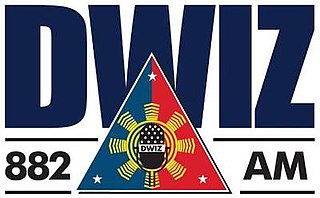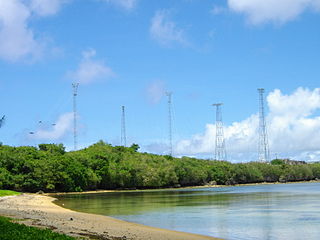Related Research Articles

Shortwave radio is radio transmission using radio frequencies in the shortwave bands (SW). There is no official definition of the band range, but it always includes all of the high frequency band (HF), which extends from 3 to 30 MHz. It lies between the medium frequency band (MF) and the bottom of the VHF band.
International broadcasting consists of radio and television transmissions that purposefully cross international boundaries, often with then intent of allowing expatriates to remain in touch with their countries of origin as well as educate, inform, and influence residents of foreign countries. Content can range from overt propaganda and counterpropaganda to cultural content to news reports that reflect the point of view and concerns of the originating country or that seek to provide alternative information to that otherwise available as well as promote tourism and trade. In the first half of the twentieth century, international broadcasting was used by colonial empires as a means of connecting colonies with the metropole. When operated by governments or entities close to a government, international broadcasting can be a form of soft power. Less frequently, international broadcasting has been undertaken for commercial purposes by private broadcasters.

Radio Moscow, also known as Radio Moscow World Service, was the official international broadcasting station of the Union of Soviet Socialist Republics until 1993, when it was reorganized into Voice of Russia, which was subsequently reorganized and renamed into Radio Sputnik in 2014. At its peak, Radio Moscow broadcast in over 70 languages using transmitters in the Soviet Union, Eastern Europe, and Cuba.

Shortwave listening, or SWLing, is the hobby of listening to shortwave radio broadcasts located on frequencies between 1700 kHz and 30 MHz (30 000 kHz). Listeners range from casual users seeking international news and entertainment programming, to hobbyists immersed in the technical aspects of long-distance radio reception and sending and collecting official confirmations that document their reception of remote broadcasts (DXing). In some developing countries, shortwave listening enables remote communities to obtain regional programming traditionally provided by local medium wave AM broadcasters. In 2002, the number of households that were capable of shortwave listening was estimated to be in the hundreds of millions.
Shortwave broadcasting in the United States allows private ownership of commercial and non-commercial shortwave stations that are not relays of existing AM/MW or FM radio stations, as are common in Africa, Europe, Asia, Oceania except Australia and Latin America. In addition to private broadcasters, the United States also has government broadcasters and relay stations for international public broadcasters. Most privately owned shortwave stations have been religious broadcasters, either wholly owned and programmed by Roman Catholic and evangelical Protestant charities or offering brokered programming consisting primarily of religious broadcasters. To better reach other continents of the world, several stations are located in far-flung US territories. Shortwave stations in the US are not permitted to operate exclusively for a domestic audience; they are subject to antenna and power requirements to reach an international audience.

CBU is a Canadian non-commercial public radio station, in Vancouver, British Columbia. It carries the programming of the CBC Radio One network. The station broadcasts on 690 AM and on 88.1 FM as CBU-2-FM. CBU's newscasts and local shows are also heard on a chain of CBC stations around the Lower Mainland.

DWIZ is a radio station owned and operated by Aliw Broadcasting Corporation, a subsidiary of the ALC Group of Companies. It serves as the flagship station of the DWIZ network, which was established in late January 2023. The station's studio is located at the 20th Floor, Citystate Centre, 709 Shaw Boulevard, Brgy. Oranbo, Pasig, and its transmitter is located along Osmeña St., Brgy. Pag-Asa, Obando, Bulacan.

Superrock KYOI was a short-wave US radio station located at Saipan island in the Pacific region from 1982 to 1989. The aim was to deliver broadcast rock and pop music to Japan, but due to short-wave distribution features it was also well-heard in the USSR, China, Australia, New Zealand, and some Pacific countries, where it became legendary.

DZFE is a non-commercial radio station owned and operated by Far East Broadcasting Company (Philippines). The station's studio and transmitter are located on the 46th floor of One Corporate Centre, Meralco Ave. cor. Doña Julia Vargas Ave., Ortigas Center, Pasig. This station operates daily from 6:00 AM to 3:00 AM the following day.

RNZ Pacific or Radio New Zealand Pacific, sometimes abbreviated to RNZP, is a division of Radio New Zealand and the official international broadcasting station of New Zealand. It broadcasts a variety of news, current affairs and sports programmes in English, and news in seven Pacific languages. The station's mission statement requires it to promote and reflect New Zealand in the Pacific, and better relations between New Zealand and Pacific countries. It was called Radio New Zealand International or RNZ International (RNZI) until May 2017.

Radio Exterior de España (REE), or simply Radio Exterior, is a Spanish free-to-air radio station owned and operated by Radio Nacional de España (RNE), the radio division of state-owned public broadcaster Radiotelevisión Española (RTVE). It is the corporation's international radio service and was launched on 15 March 1942. It is considered to be Spain's equivalent to the BBC World Service, Deutsche Welle and Radio Canada International.
Feba Radio is a British-founded broadcasting network. It is driven by Christian values rather than by government or commercial aims.

Radio broadcasting in the Philippines existed since the 1920s, and has a strong following. Estimates on the number or radio stations range from 1,200 to 1,500.
The following radio stations broadcast on AM frequency 1188 kHz:

Far East Broadcasting Company (FEBC) is an international Christian radio network. From 1960 to 1994, FEBC owned and operated shortwave radio station KGEI in San Francisco, California.
WSZE-TV was a television station broadcasting on channel 10 on Saipan, the largest of the Northern Mariana Islands. The first station to be constructed on the island, it was owned by the Micronesian Broadcasting Corporation alongside WSZE AM and FM radio; it was a sister station to KUAM-TV, the commercial television station in Guam. It operated from 1969 to 1980.
KGEI was a shortwave radio station founded by General Electric in 1939. It was purchased by the Far East Broadcasting Company in 1960.
KSAI may refer to:
Kyokuto Hoso Radio (極東放送) was a Japanese commercial radio station broadcasting to Okinawa Prefecture, founded in 1958 as a division of the Far East Broadcasting Company before switching to a secular commercial operation following the reversion of control of Okinawa to Japan, it was headquartered in Urasoe and had JOTF as its callsign. It is considered to be the predecessor of the current FM Okinawa.